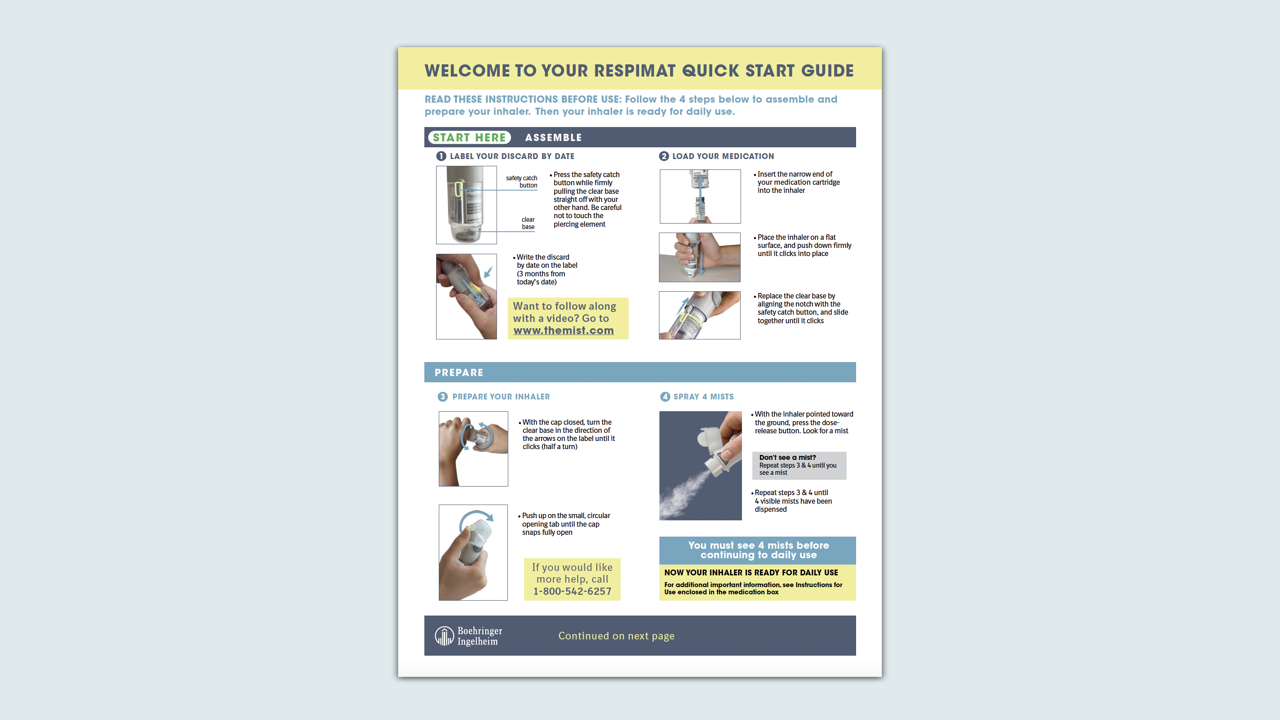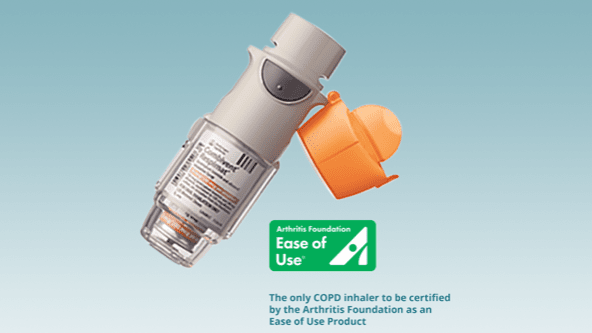How to Prepare and Use the RESPIMAT Inhaler
Quick Start Guide
The COMBIVENT RESPIMAT Inhaler is easy to use. This Quick Start Guide will show you everything you need to know.

Additional Instructions for First-Time Use
After preparing your inhaler, just remember T.O.P. for daily use
Turn the clear base
Open the cap and close your lips around the mouthpiece
Press the dose-release button and inhale the mist

Your RESPIMAT inhaler helps make the most of your COMBIVENT treatment

Designed with you in mind
The COMBIVENT RESPIMAT inhaler was designed to help you breathe in your medicine. It delivers a soft mist that eases the effort to inhale the medicine so it can get where it needs to go. COMBIVENT RESPIMAT is not for sudden COPD symptoms. Always carry a rescue inhaler.
Answers to Common Questions

Open the cap, press the dose-release button, then insert the cartridge. Place the inhaler on a firm surface and push down firmly until it clicks into place.
Insert the cartridge with the narrow end first.
If not, turn the clear base in a continuous movement until it clicks (half a turn).
The COMBIVENT RESPIMAT inhaler is locked after 120 puffs (120 doses). If you have a sample, the COMBIVENT RESPIMAT inhaler is locked after 60 puffs (60 doses). Prepare and use your new COMBIVENT RESPIMAT inhaler.
If the clear base has already been turned, follow steps "Open" and "Press" under "Daily use" to get your medicine.
COMBIVENT RESPIMAT will deliver 120 puffs and last 30 days if used at 1 puff four times daily. If you have a sample, COMBIVENT RESPIMAT will deliver 60 puffs and last 15 days if used at 1 puff four times daily.
The dose indicator counts each turn of the clear base regardless of whether a cartridge has been inserted or not.
Once you have prepared COMBIVENT RESPIMAT, no test-spraying is required if used daily.
Always insert a new cartridge into a NEW COMBIVENT RESPIMAT.
Close the cap, then turn the clear base.
Close the cap, so the dose-release button is covered, then turn the clear base.
Turn the clear base in a continuous movement until it clicks (half a turn).
If not, insert a cartridge.
Repeat Turn, Open, Press (TOP) three times after inserting the cartridge as shown in steps 4 to 6 under “Prepare for first use.”
You have used up all your medicine and the inhaler is locked.
COMBIVENT RESPIMAT (ipratropium bromide and albuterol) is indicated for use in patients with chronic obstructive pulmonary disease (COPD) on a regular aerosol bronchodilator who continue to have evidence of bronchospasm (airway narrowing) and who require a second bronchodilator.
Do not use COMBIVENT RESPIMAT if you are allergic to any of the ingredients in COMBIVENT RESPIMAT or to atropine or other similar drugs.
COMBIVENT RESPIMAT can cause the narrowing of the airways to get worse (paradoxical bronchospasm) which may be life threatening. If this happens, stop taking COMBIVENT RESPIMAT at once and call your doctor or get emergency help.
COMBIVENT RESPIMAT can cause serious heart-related side effects, such as palpitations, chest pain, rapid heart rate, high blood pressure, tremor, or nervousness. Call your doctor if you experience any of these symptoms.
Avoid spraying COMBIVENT RESPIMAT into your eyes. COMBIVENT RESPIMAT may increase eye pressure which may cause or worsen some types of glaucoma. If you have sudden vision changes, eye pain or visual halos, stop taking COMBIVENT RESPIMAT and call your doctor right away.
COMBIVENT RESPIMAT may cause difficulty with urination.
Dizziness and blurred vision may occur with COMBIVENT RESPIMAT. Should you experience these symptoms, use caution when engaging in activities such as driving a car or operating appliances or other machines.
Do not use COMBIVENT RESPIMAT more often than your doctor has directed. Deaths have been reported with similar inhaled medicines in asthma patients who use the medicine too much. Seek medical attention if your treatment with COMBIVENT RESPIMAT becomes less effective for symptomatic relief, your symptoms become worse, and/or you need to use the product more frequently than usual.
Allergic reactions may occur, including itching, swelling of the face, lips, tongue, or throat (involving difficulty in breathing or swallowing), rash, hives, bronchospasm (airway narrowing), or anaphylaxis. Some of these may be serious. If you experience any of these symptoms, stop taking COMBIVENT RESPIMAT at once and call your doctor or get emergency help.
Tell your doctor about all your medical conditions, especially if you have narrow-angle glaucoma, prostate or urinary problems, a history of heart conditions (such as irregular heartbeat, high blood pressure), thyroid disorder, or diabetes. Also tell your doctor if you are pregnant or nursing. Tell your doctor about all medicines you are taking, especially heart medications or drugs to treat depression.
The most common side effects reported with use of COMBIVENT RESPIMAT include infection of the ears, nose, and throat, runny nose, cough, bronchitis, headache, and shortness of breath.
Click here for full Prescribing Information and Patient Instructions for Use.
You are encouraged to report negative side effects of prescription drugs to the FDA. Visit www.fda.gov/medwatch or call 1-800-FDA-1088.
CL-CBR-100003

